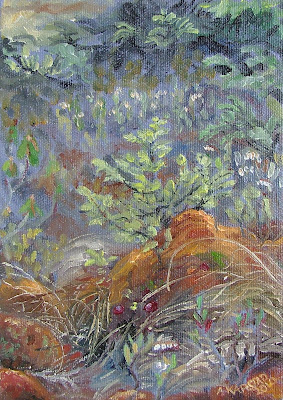Little Bog Spruce (oil on canvas 5 x 7 in.)
13 May finds me again painting a little spruce tree, but this one is not young like yesterday's sapling in the woods. It is a Black Spruce, and no younger than the tall club-tipped Black Spruces at the edges of the bog. We've known this bog for many years, and I'm pleased to be able to paint in it again.
From the highway, you can tell it's a bog by the way the trees are shorter toward the centre, and spaced out by moss and shrubs. The pillow of moss that is growing up around the base of this little tree is Sphagnum, the acid-producing environment of everything that grows in the bog. Growth here is very slow, as organic decomposition almost doesn't happen. The living and dead Sphagnum, and the water that it holds, is antiseptic. Nutrients are available to the roots of plants mainly through the action of micorhyzal fungi. Most bog plants retain their leaves through the winter, as it is expensive to grow new ones.
Many of my old bog friends are here. Leatherleaf is in bloom, each vertical-leaved stem tipped by a row of tiny white bells. Bog Rosemary also, but smaller, glossy, rolled-in leaves with white undersides (also held vertically) is blooming in pink. The droopy-leaved plants are Labrador Tea (with orange fuzz on the undersides) and Bog Laurel (with smooth undersides). The pale, thin grass-like leaves are last year's Carex. It will grow new this summer, as will Bog Lily, whose old leaves litter the sphagnum in places like scraps of wet brown paper tissue.
Walking with long strides like a heron, trying to make minimal impression in the garden-like bog surface, I spot an artifact that appears to be balanced on the branches of a low spruce - a dry fox dropping entirely composed of compacted mouse fur and tiny bones. The felty fur inside is slightly yellow- dusty with what I guess must be the fruits of a special fungus that finished off the fox's meal. The next step in the processing of this dropping will be to break it up, extract the teeth, and send them to a mammalogist to find out what kind of mice the fox was eating.
This original oil painting is available at $275. For information on purchase and shipping, please contact me at karstad@pinicola.ca
From the highway, you can tell it's a bog by the way the trees are shorter toward the centre, and spaced out by moss and shrubs. The pillow of moss that is growing up around the base of this little tree is Sphagnum, the acid-producing environment of everything that grows in the bog. Growth here is very slow, as organic decomposition almost doesn't happen. The living and dead Sphagnum, and the water that it holds, is antiseptic. Nutrients are available to the roots of plants mainly through the action of micorhyzal fungi. Most bog plants retain their leaves through the winter, as it is expensive to grow new ones.
Many of my old bog friends are here. Leatherleaf is in bloom, each vertical-leaved stem tipped by a row of tiny white bells. Bog Rosemary also, but smaller, glossy, rolled-in leaves with white undersides (also held vertically) is blooming in pink. The droopy-leaved plants are Labrador Tea (with orange fuzz on the undersides) and Bog Laurel (with smooth undersides). The pale, thin grass-like leaves are last year's Carex. It will grow new this summer, as will Bog Lily, whose old leaves litter the sphagnum in places like scraps of wet brown paper tissue.
Walking with long strides like a heron, trying to make minimal impression in the garden-like bog surface, I spot an artifact that appears to be balanced on the branches of a low spruce - a dry fox dropping entirely composed of compacted mouse fur and tiny bones. The felty fur inside is slightly yellow- dusty with what I guess must be the fruits of a special fungus that finished off the fox's meal. The next step in the processing of this dropping will be to break it up, extract the teeth, and send them to a mammalogist to find out what kind of mice the fox was eating.
This original oil painting is available at $275. For information on purchase and shipping, please contact me at karstad@pinicola.ca




Comments
Post a Comment
What do you think of this painting, and what do you know about the subject that I have painted?